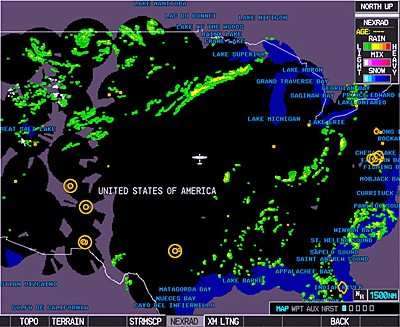NEXRAD 'Age Indicator' Can Be Misleading
The NTSB on Tuesday issued a Safety Alert to warn pilots using in-cockpit FIS-B and Satellite Weather display systems that the NEXRAD "age indicator" can be misleading. The actual NEXRAD data can be as much as 20 minutes older than the age indication on the display in the cockpit. If misinterpreted, this difference in time can present potentially serious safety hazards to aircraft operating in the vicinity of fast-moving and quickly developing weather systems.

NEXRAD mosaic imagery depicts weather conditions from multiple ground radar sites. The NEXRAD "age-indicator" on the cockpit display indicates the time that the mosaic image was created, not the time of the actual weather conditions. The NEXRAD image is always older than the actual weather conditions.
The NTSB has cited two fatal weather-related aircraft accidents in which NEXRAD images were displayed to the pilot that were presented as one-minute old on the age-indicator, but contained information that was up to five to eight minutes behind the real-time conditions. The NTSB has cited two fatal weather-related aircraft accidents in which NEXRAD images were displayed to the pilot that were presented as one-minute old on the age-indicator, but contained information that was up to five to eight minutes behind the real-time conditions. On March 25, 2010, a Eurocopter AS350 B3, N855HW, impacted terrain near Brownsville, Tennessee.2 During the flight, the pilot’s cockpit display indicated that it had received one NEXRAD image roughly halfway through the flight that indicated it was about 1 minute old; however, the weather conditions were actually about 5 minutes old. The image indicated that the severe weather was about 7 miles away from the home base where the pilot was attempting to land, but
the severe weather was actually just crossing over the home base at about the time the display received the NEXRAD image.

On December 19, 2011, a Piper PA-32-260, N3590T, collided with terrain following an in-flight breakup near Bryan, Texas.3 The pilot had been diverting to avoid weather and had likely received several NEXRAD updates in the minutes leading up to the accident. According to the NEXRAD data the pilot likely would have received, he was flying clear of the precipitation along the edge of the rain. Near the end of the flight, the pilot flew into a section of the developing rain shower. His display should have shown that he still remained clear of the precipitation. The last three NEXRAD updates that the pilot received should have each said that they were 1 minute old at the time they were received; however, the actual weather conditions at the time the images were received in the cockpit were about 6, 7, and almost 8 minutes old, respectively.
The Board said in the Safety Alert that "the in-cockpit NEXRAD display depicts where the weather WAS, not where it IS. The age indicator does not show the age of the actual weather conditions but rather the age of the mosaic image. The actual weather conditions could be up to 15 to 20 minutes OLDER than the age indicated on the display. You should consider this potential delay when using in-cockpit NEXRAD capabilities, as the movement and/or intensification of weather could adversely affect safety of flight."
In addition to raising pilot awareness on this issue, the Safety Alert also reminds pilots of the importance of obtaining a thorough preflight weather briefing. (Image sample of NEXRAD weather information not to be considered indicative of any accident)
 ANN's Daily Aero-Term (04.20.24): Light Gun
ANN's Daily Aero-Term (04.20.24): Light Gun Aero-News: Quote of the Day (04.20.24)
Aero-News: Quote of the Day (04.20.24) ANN's Daily Aero-Linx (04.21.24)
ANN's Daily Aero-Linx (04.21.24) Aero-News: Quote of the Day (04.21.24)
Aero-News: Quote of the Day (04.21.24) ANN's Daily Aero-Term (04.21.24): Aircraft Conflict
ANN's Daily Aero-Term (04.21.24): Aircraft Conflict




